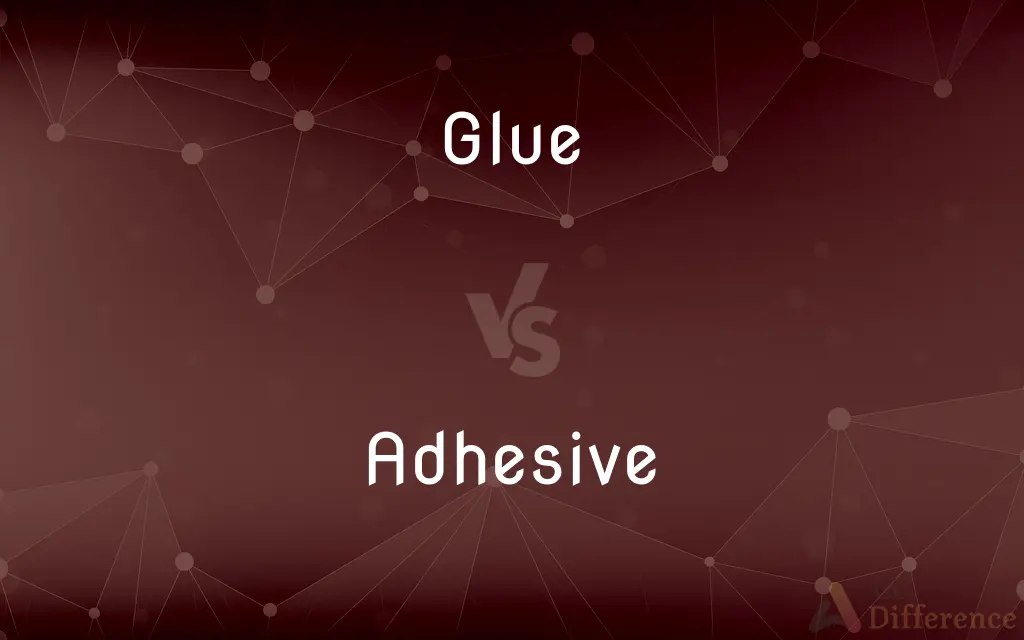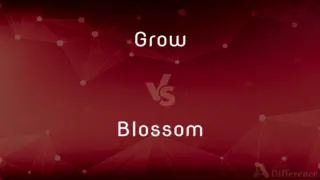Glue vs. Adhesive — What's the Difference?
Edited by Tayyaba Rehman — By Maham Liaqat — Updated on March 22, 2024
Glue is a specific type of adhesive derived from organic sources or synthetically made for bonding materials, whereas adhesive is a broader category encompassing substances like glues, tapes, and cements that join surfaces together.

Difference Between Glue and Adhesive
Table of Contents
ADVERTISEMENT
Key Differences
Glue and adhesive are terms often used interchangeably in everyday language, but they hold distinct meanings in technical contexts. Adhesive serves as an umbrella term for any material that can bind objects together through surface attachment. This category includes a wide range of products, from natural glues made from organic materials to synthetic adhesives engineered for specific industrial applications, such as epoxies, silicones, and acrylics.
Glue, historically derived from natural sources like animal collagen, casein from milk, or vegetable sources, is a subset of adhesives characterized by its natural origin and general-purpose use in crafts, woodworking, and simple repairs. Modern glues can also be synthetic, designed to mimic or improve upon the properties of natural glues, offering stronger bonds or more specialized applications.
The distinction between glue and adhesive becomes clearer in industrial and manufacturing contexts, where adhesives are selected based on specific criteria such as temperature resistance, load-bearing capacity, and chemical exposure. Adhesives like epoxy or polyurethane are chosen for their strength and durability in bonding a wide range of materials, including metals, plastics, and ceramics, beyond the capacity of traditional glues.
While glue is often associated with simplicity and general utility, the term adhesive implies a broader spectrum of bonding technologies, including structural adhesives that contribute to the integrity of buildings, vehicles, and machinery. The development of advanced adhesive technologies has expanded the potential for material innovation, lightweight construction, and sustainable manufacturing practices.
In summary, while all glues are adhesives, not all adhesives are glues. The choice between a glue and a more specialized adhesive depends on the materials to be bonded, the required strength of the bond, and the conditions to which the bond will be exposed.
ADVERTISEMENT
Comparison Chart
Origin
Traditionally natural, now also synthetic
Can be natural or synthetic
Composition
Animal collagen, casein, vegetable extracts
Includes epoxies, silicones, acrylics, tapes, and cements
Applications
Crafts, woodworking, simple repairs
Wide-ranging, including industrial and structural applications
Strength
Generally lower compared to some specialized adhesives
Varies, with some designed for high-strength, durable bonds
Flexibility
Limited by nature or formulation
Broad, tailored to specific requirements like temperature and chemical resistance
Use
General-purpose, everyday bonding tasks
Specific to material, environment, and performance needs
Innovation
Modern versions improve upon traditional formulas
Continuous development for new materials and applications
Compare with Definitions
Glue
Glue is a substance used for joining things together, often made from organic materials.
Wood glue is used to bond wooden pieces in furniture making.
Adhesive
Adhesive is a broad term for materials that bond surfaces together.
Industrial adhesives are used in assembling automotive parts.
Glue
Can be derived from natural sources like animal collagen.
Traditional hide glue is used in restoring antique furniture.
Adhesive
Encompasses a wide variety of compositions.
Silicone adhesives are used for their heat resistance in electronics.
Glue
Has a history of use across cultures and eras.
Ancient Egyptians used glue made from animal products in woodworking.
Adhesive
Continuously developed for advanced applications.
Aerospace adhesives withstand extreme conditions in aircraft construction.
Glue
Includes modern synthetic versions.
Super glue quickly bonds a wide range of materials with a strong hold.
Adhesive
Can include tapes and cements.
Double-sided tape provides easy application for mounting and decorating.
Glue
Suitable for crafts and simple repairs.
School glue is safe and easy for children to use in projects.
Adhesive
Tailored for specific applications beyond simple bonding.
Medical adhesives are designed for safe use on skin and in surgeries.
Glue
A strong liquid adhesive obtained by boiling collagenous animal parts such as bones, hides, and hooves into hard gelatin and then adding water.
Adhesive
Adhesive, also known as glue, cement, mucilage, or paste, is any non-metallic substance applied to one or both surfaces of two separate items that binds them together and resists their separation.The use of adhesives offers certain advantages over other binding techniques such as sewing, mechanical fastenings, or welding. These include the ability to bind different materials together, the more efficient distribution of stress across a joint, the cost-effectiveness of an easily mechanized process, and greater flexibility in design.
Glue
Any of various similar adhesives, such as paste, mucilage, or epoxy.
Adhesive
Tending to adhere; sticky.
Glue
An adhesive force or factor
Idealism was the glue that held our group together.
Adhesive
Gummed so as to adhere.
Glue
To stick, fasten, or cause to adhere
Glued the broken leg of the chair together.
Adhesive
Tending to persist; difficult if not impossible to shake off
"He feels an adhesive dread, a sudden acquaintance with the ... darker side of mankind" (George F. Will).
Glue
To cause to be focused on or directed at something
Our eyes were glued to the stage.
Adhesive
A substance, such as paste or cement, that provides or promotes adhesion.
Glue
A hard gelatin made by boiling bones and hides, used in solution as an adhesive; or any sticky adhesive substance.
Adhesive
Sticky; tenacious, as glutinous substances
Adhesive material
Adhesive tape
Glue
(figurative) Anything that binds two things or people together.
Adhesive
Apt or tending to adhere; clinging
Glue
(transitive) To join or attach something using glue.
I need to glue the chair-leg back into place.
Adhesive
A substance, such as glue, that provides or promotes adhesion
Glue
(transitive) To cause something to adhere closely to; to follow attentively.
His eyes were glued to the screen.
Adhesive
Sticky; tenacious, as glutinous substances.
Glue
A hard brittle brownish gelatin, obtained by boiling to a jelly the skins, hoofs, etc., of animals. When gently heated with water, it becomes viscid and tenaceous, and is used as a cement for uniting substances. The name is also given to other adhesive or viscous substances.
Adhesive
Apt or tending to adhere; clinging.
Glue
Cement consisting of a sticky substance that is used as an adhesive
Adhesive
A substance that unites or bonds surfaces together
Glue
Join or attach with or as if with glue;
Paste the sign ont the wall
Cut and paste the sentence in the text
Adhesive
Tending to adhere
Glue
Be fixed as if by glue;
His eyes were glued on her
Common Curiosities
How is adhesive different from glue?
Adhesive is a broader category that includes all types of substances used for joining materials, including glues, tapes, and cements, with a wide range of applications.
What is glue?
Glue is a substance used for bonding materials together, traditionally made from organic sources but now also synthetically produced.
Are synthetic glues better than natural glues?
Synthetic glues can offer improved properties like strength and versatility, but the choice between synthetic and natural glues depends on the specific application and requirements.
Is it possible to use adhesives in underwater applications?
Yes, specific adhesives designed for underwater use, such as certain epoxies and silicones, can bond materials effectively in wet conditions.
What types of adhesives are used in construction?
In construction, strong and durable adhesives like epoxies and polyurethane are used for structural bonding and sealing.
What innovations exist in adhesive technology?
Innovations include bio-based adhesives, adhesives for extreme conditions like space and underwater use, and smart adhesives that change properties in response to stimuli.
Can all glues be considered adhesives?
Yes, all glues fall under the broader category of adhesives but are specifically known for their organic or synthetic origins aimed at simple bonding tasks.
How do I choose between glue and another type of adhesive?
The choice depends on the materials to be bonded, the required strength, environmental conditions, and whether the application is for general or specialized use.
What role do adhesives play in sustainable manufacturing?
Adhesives can enable the use of lighter, more sustainable materials, reduce the need for mechanical fasteners, and contribute to energy efficiency and recyclability.
Can adhesives be environmentally friendly?
Yes, there are environmentally friendly adhesives made from renewable resources, and efforts are being made to develop adhesives that are more biodegradable and less toxic.
Share Your Discovery

Previous Comparison
Canal vs. Aqueduct
Next Comparison
Grow vs. BlossomAuthor Spotlight
Written by
Maham LiaqatEdited by
Tayyaba RehmanTayyaba Rehman is a distinguished writer, currently serving as a primary contributor to askdifference.com. As a researcher in semantics and etymology, Tayyaba's passion for the complexity of languages and their distinctions has found a perfect home on the platform. Tayyaba delves into the intricacies of language, distinguishing between commonly confused words and phrases, thereby providing clarity for readers worldwide.















































